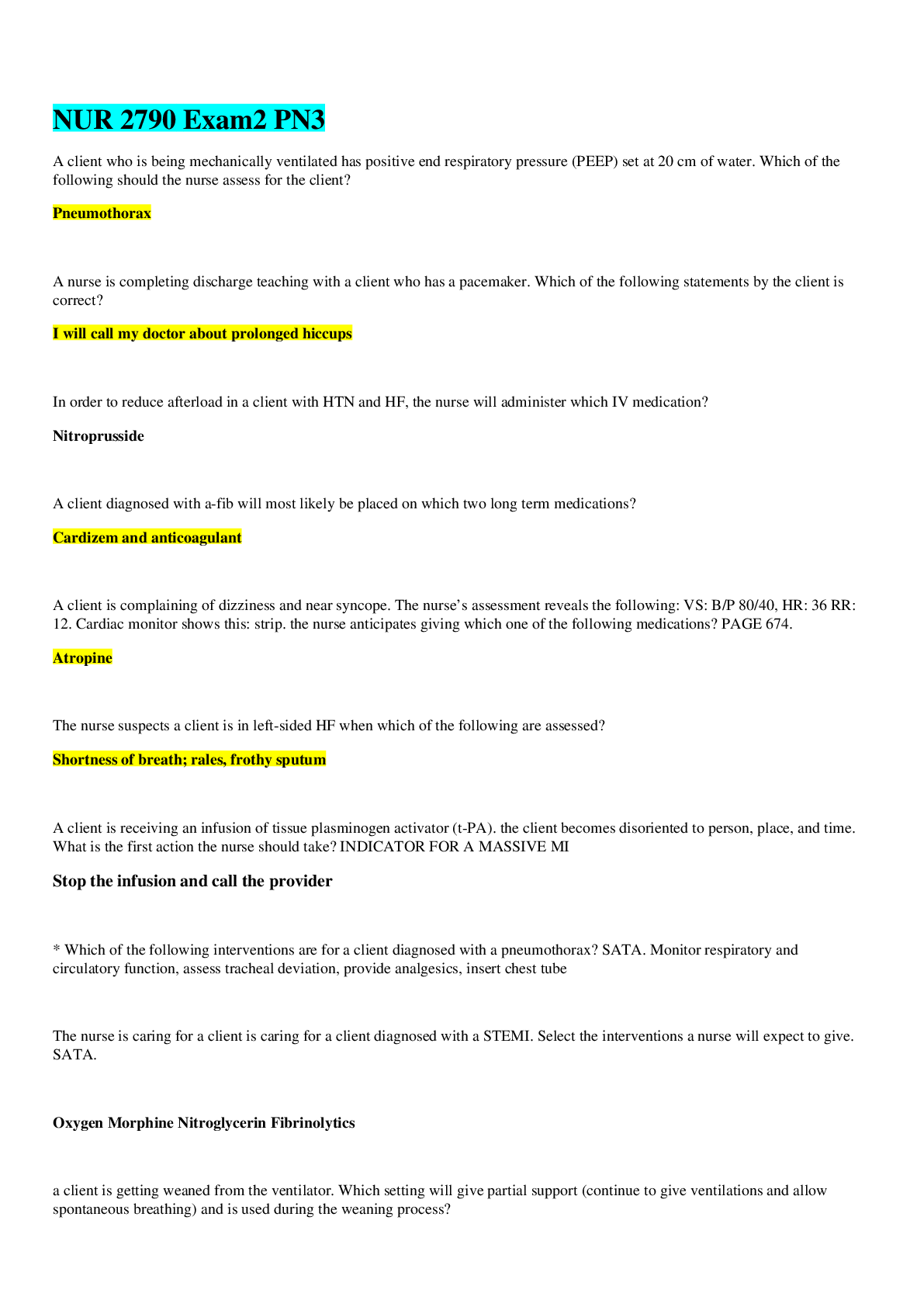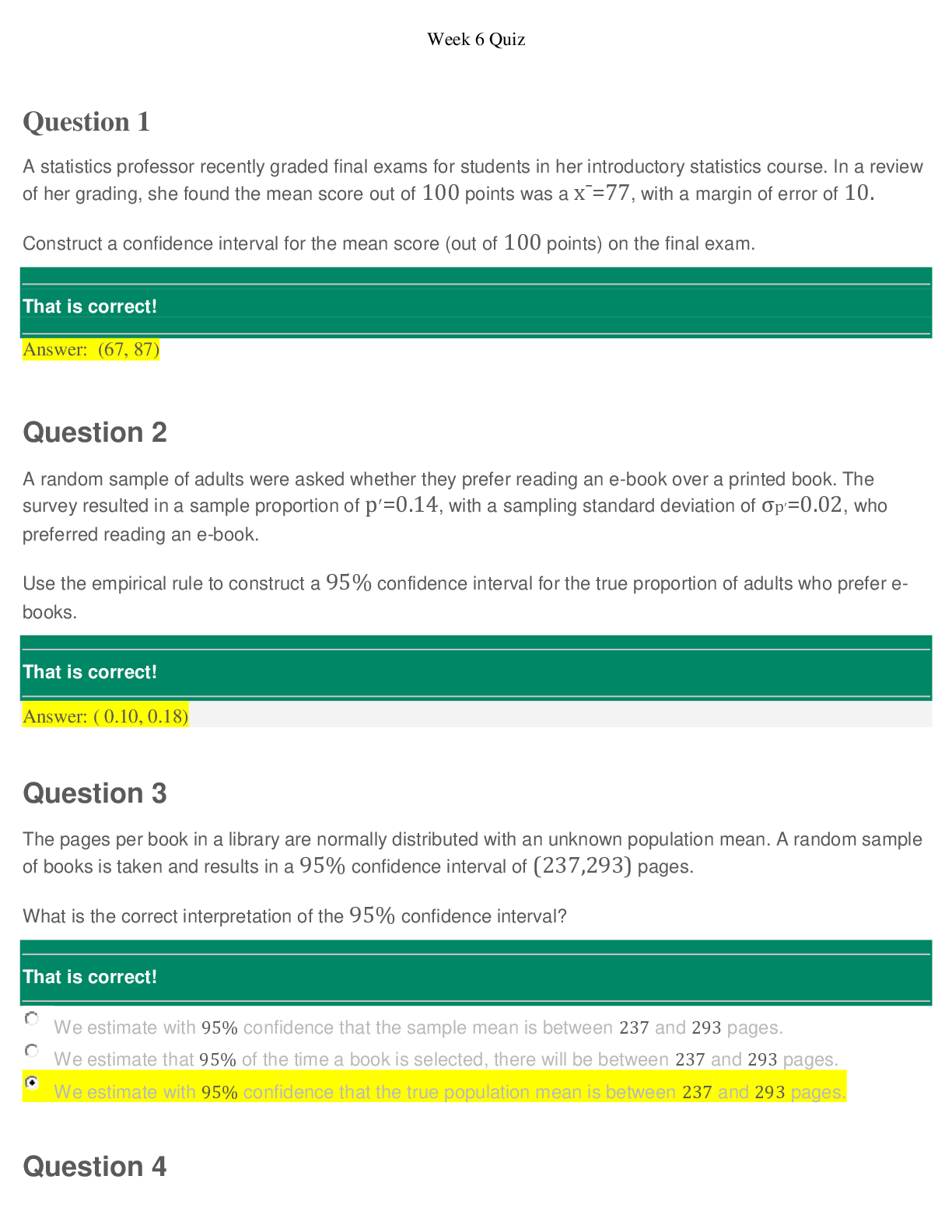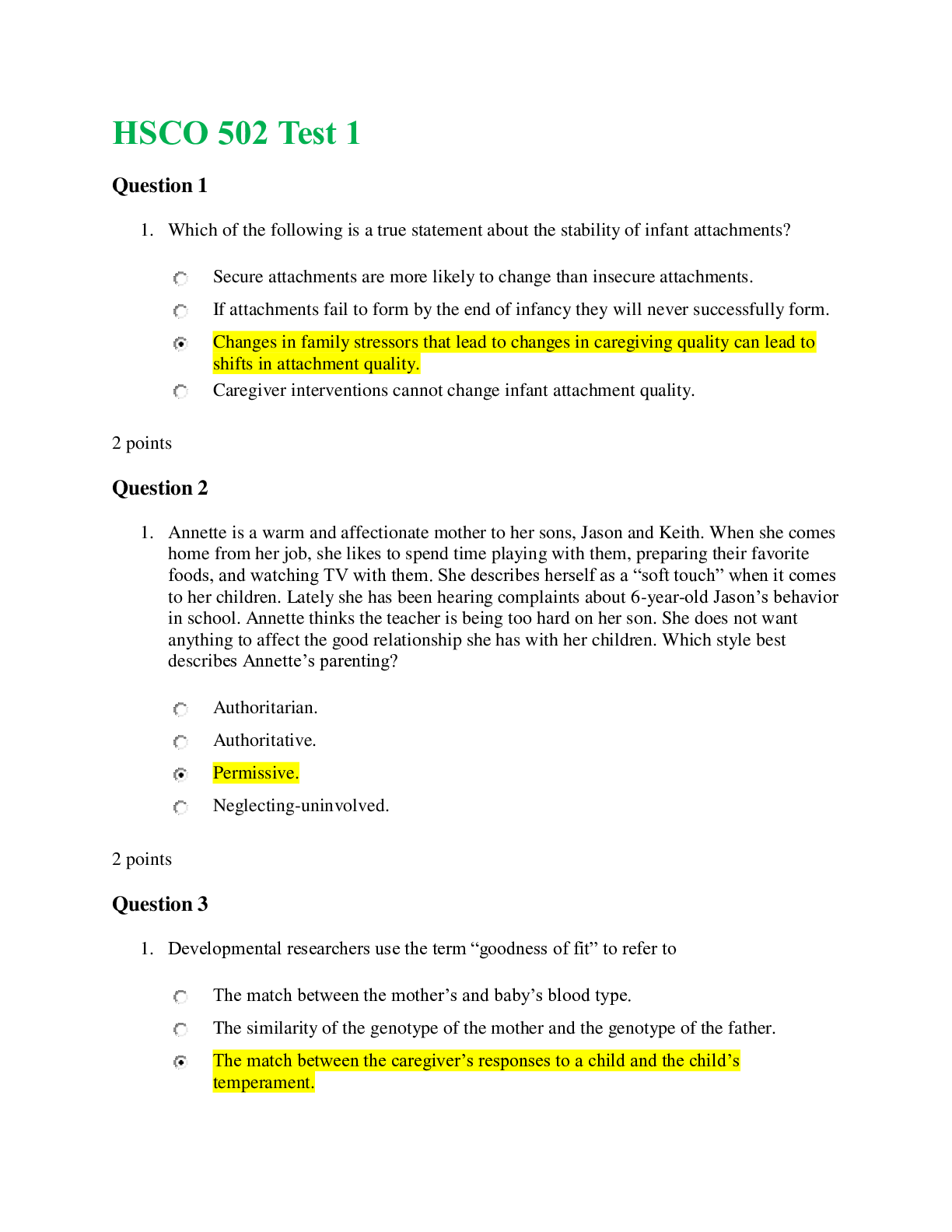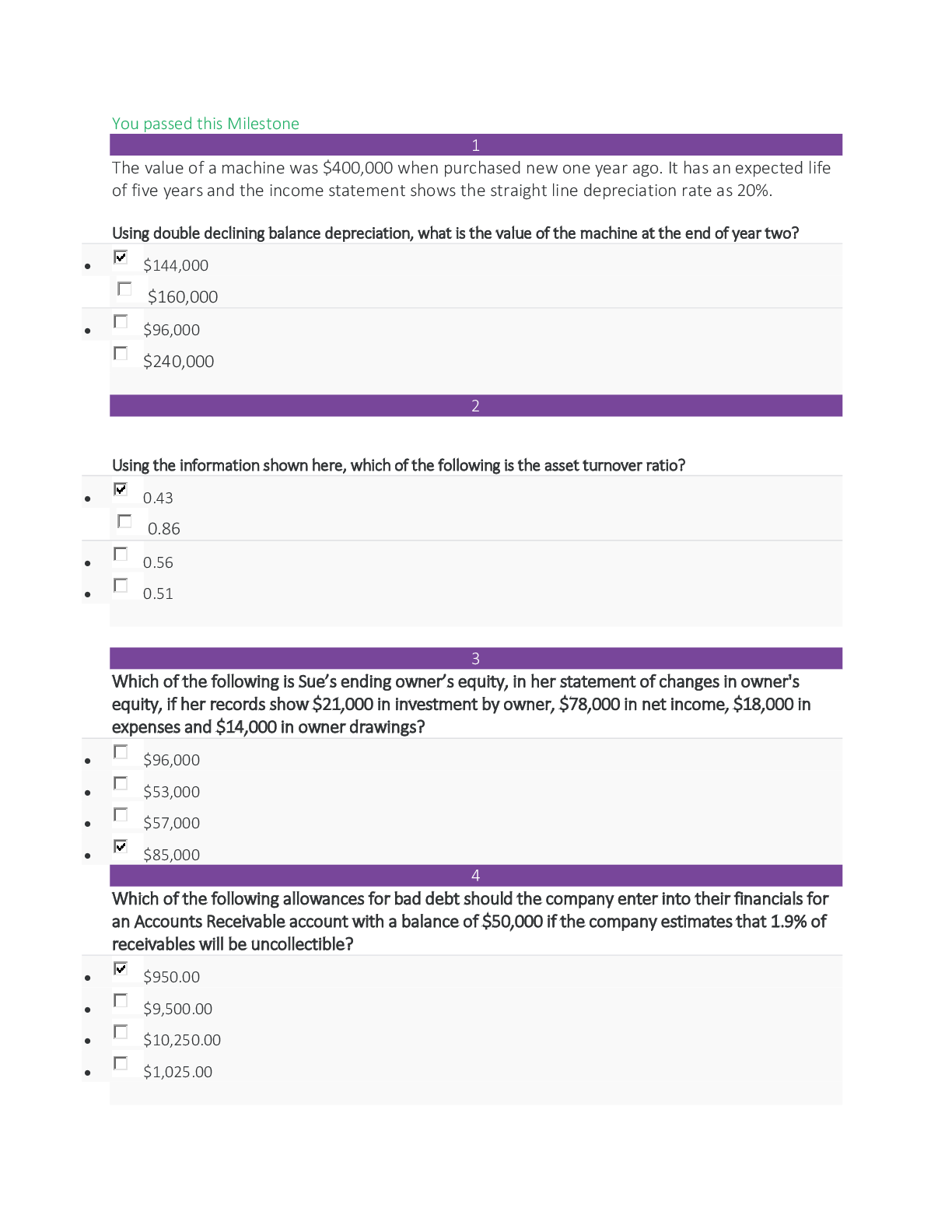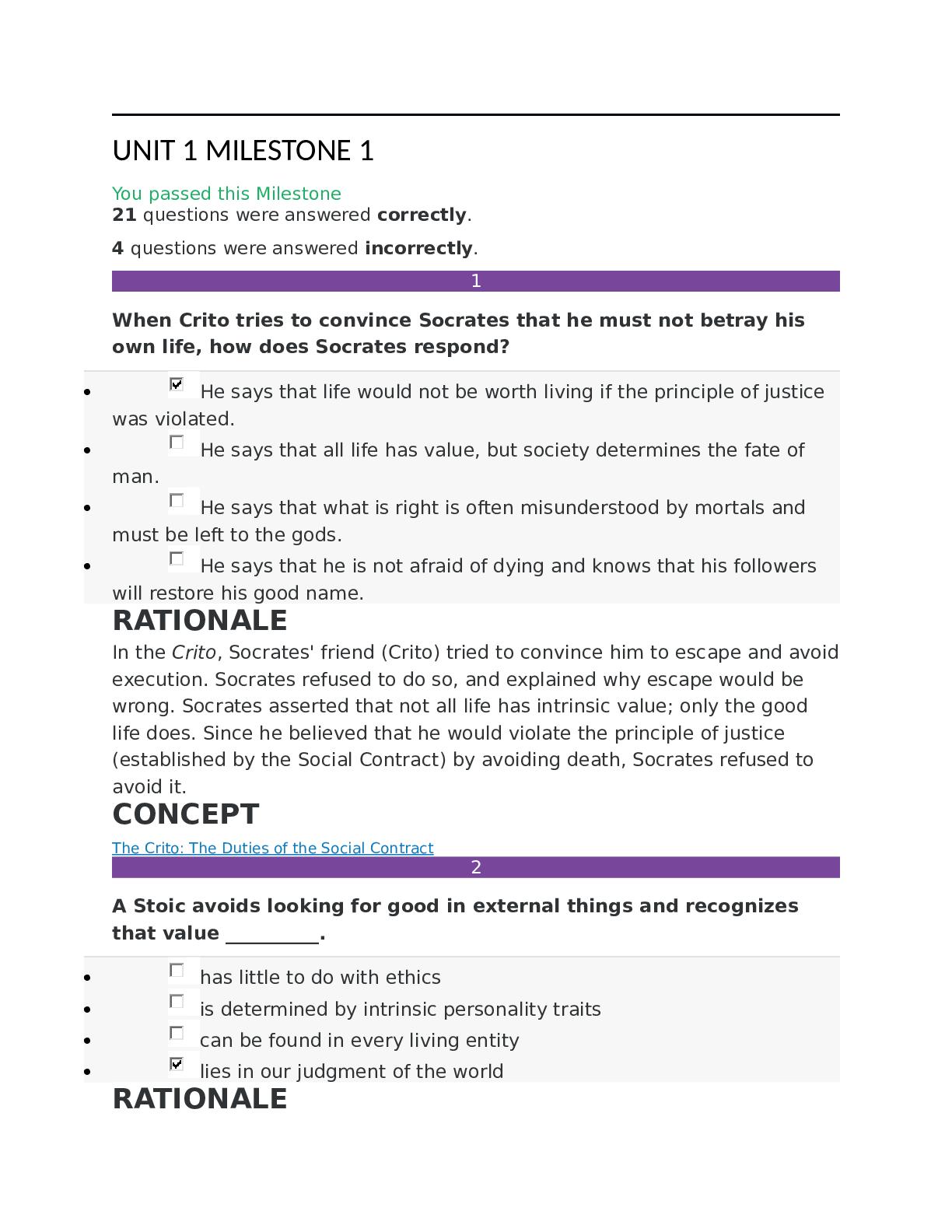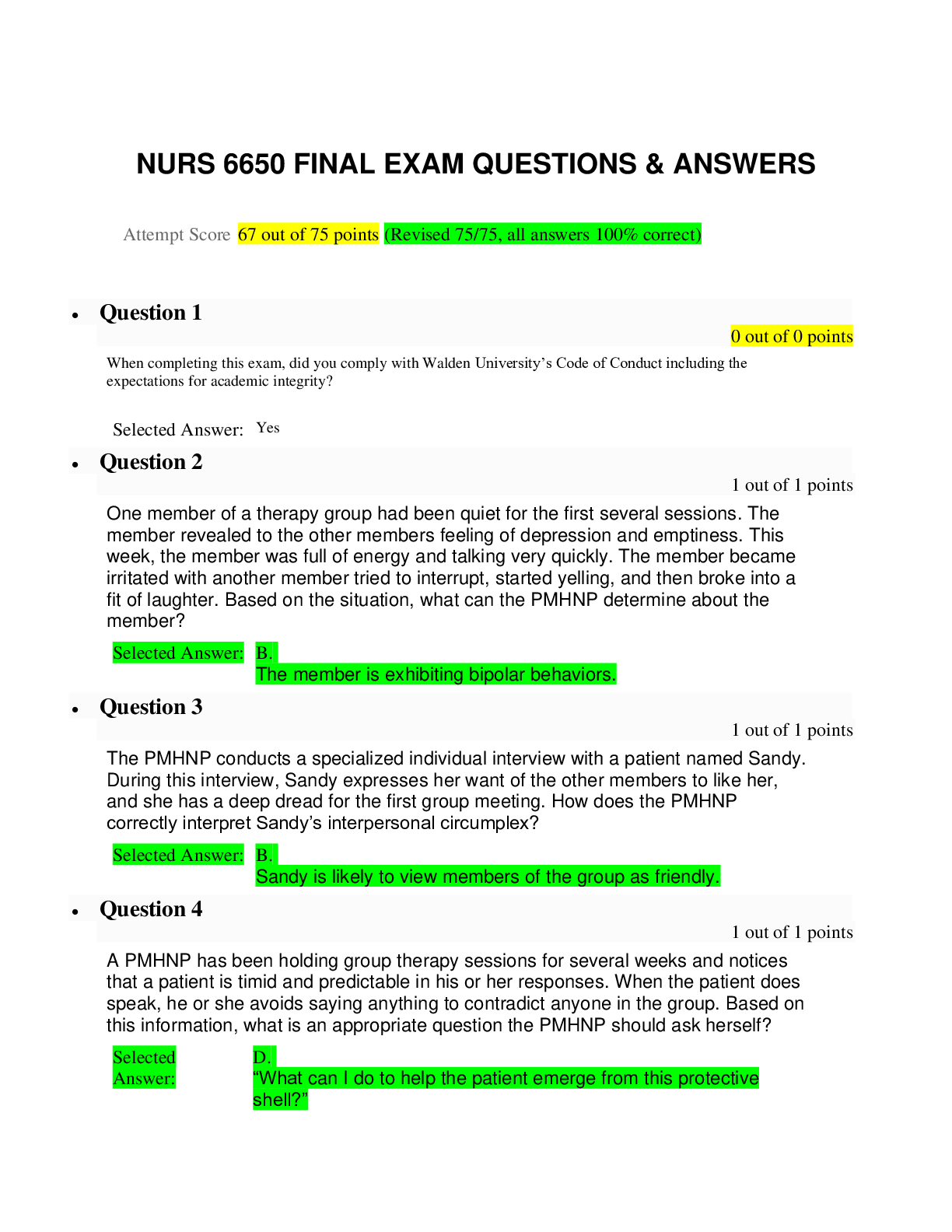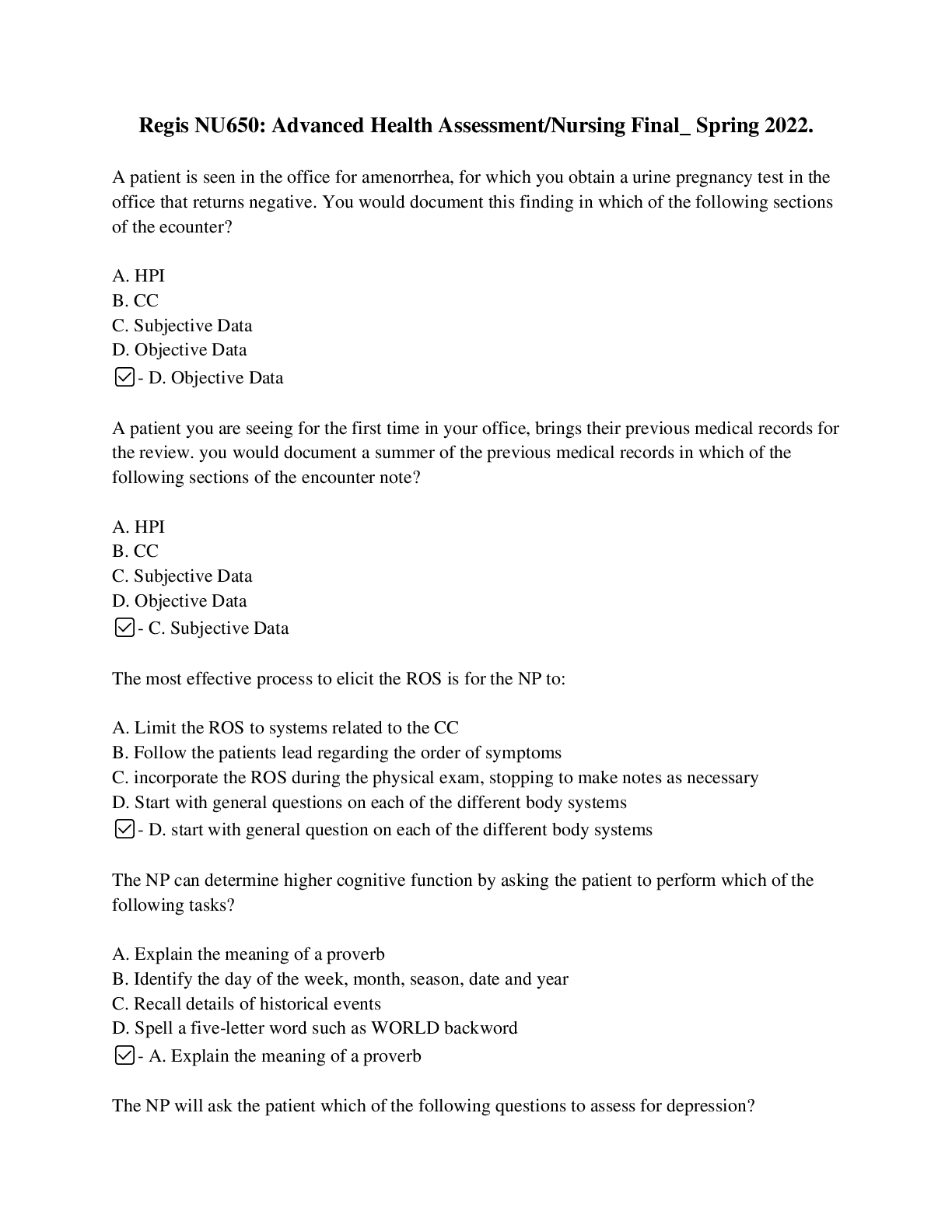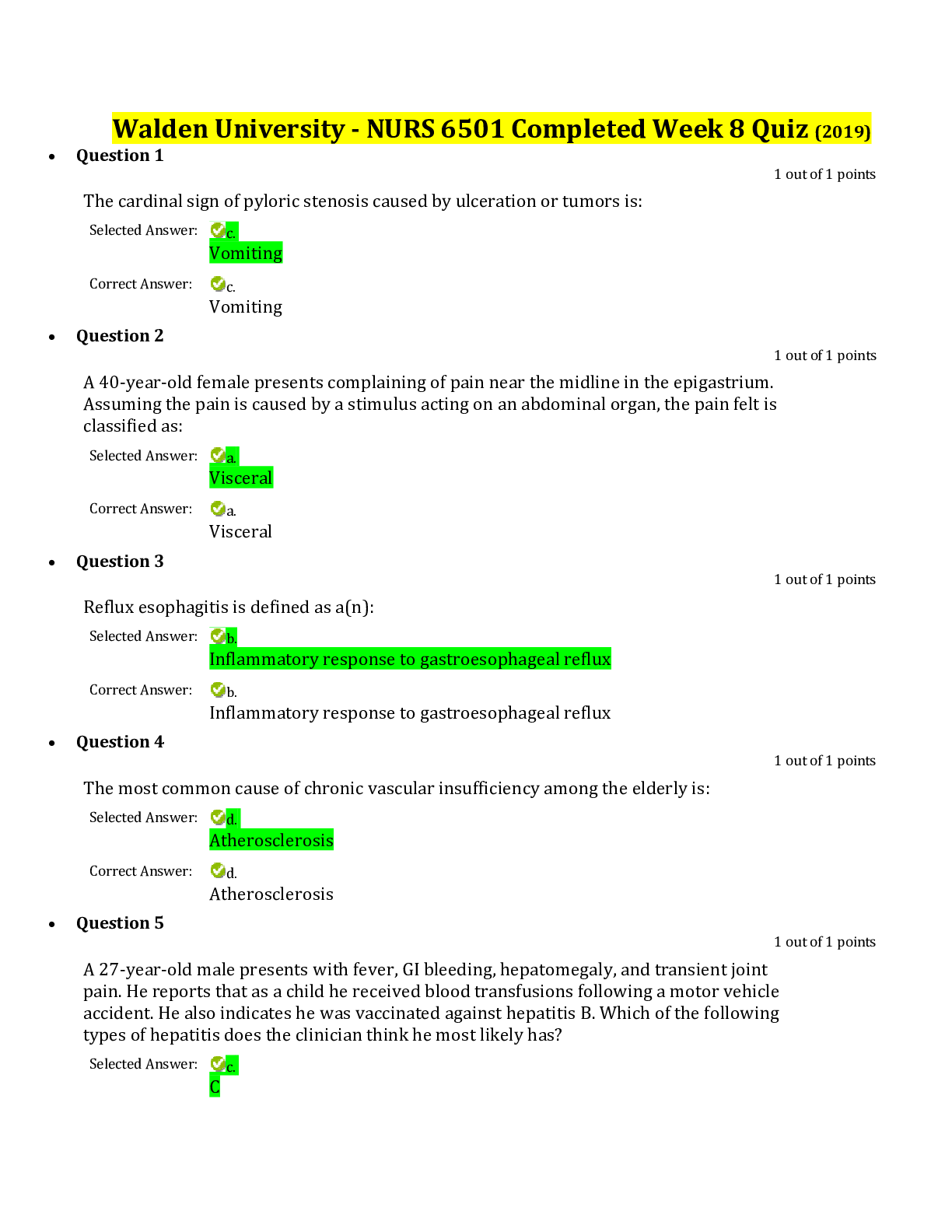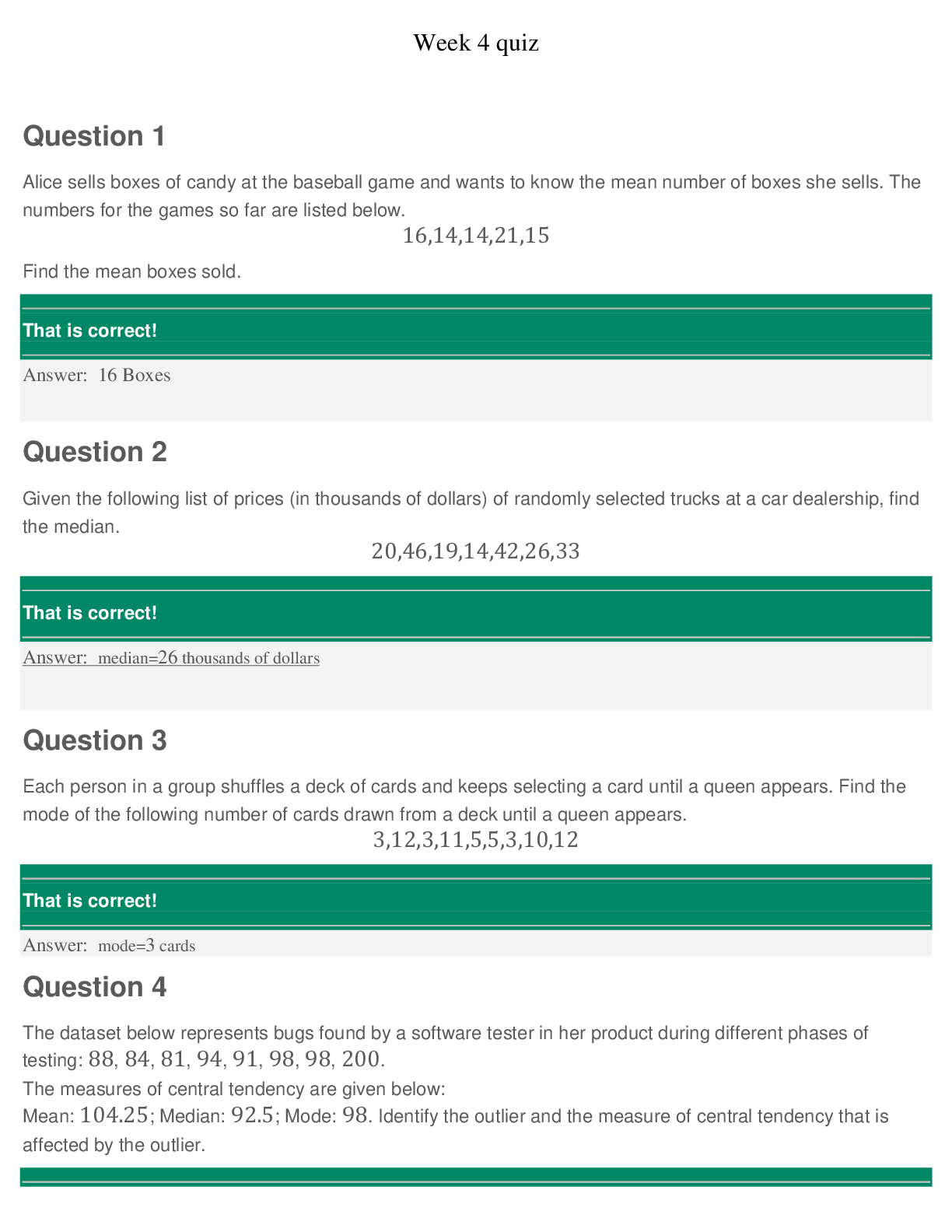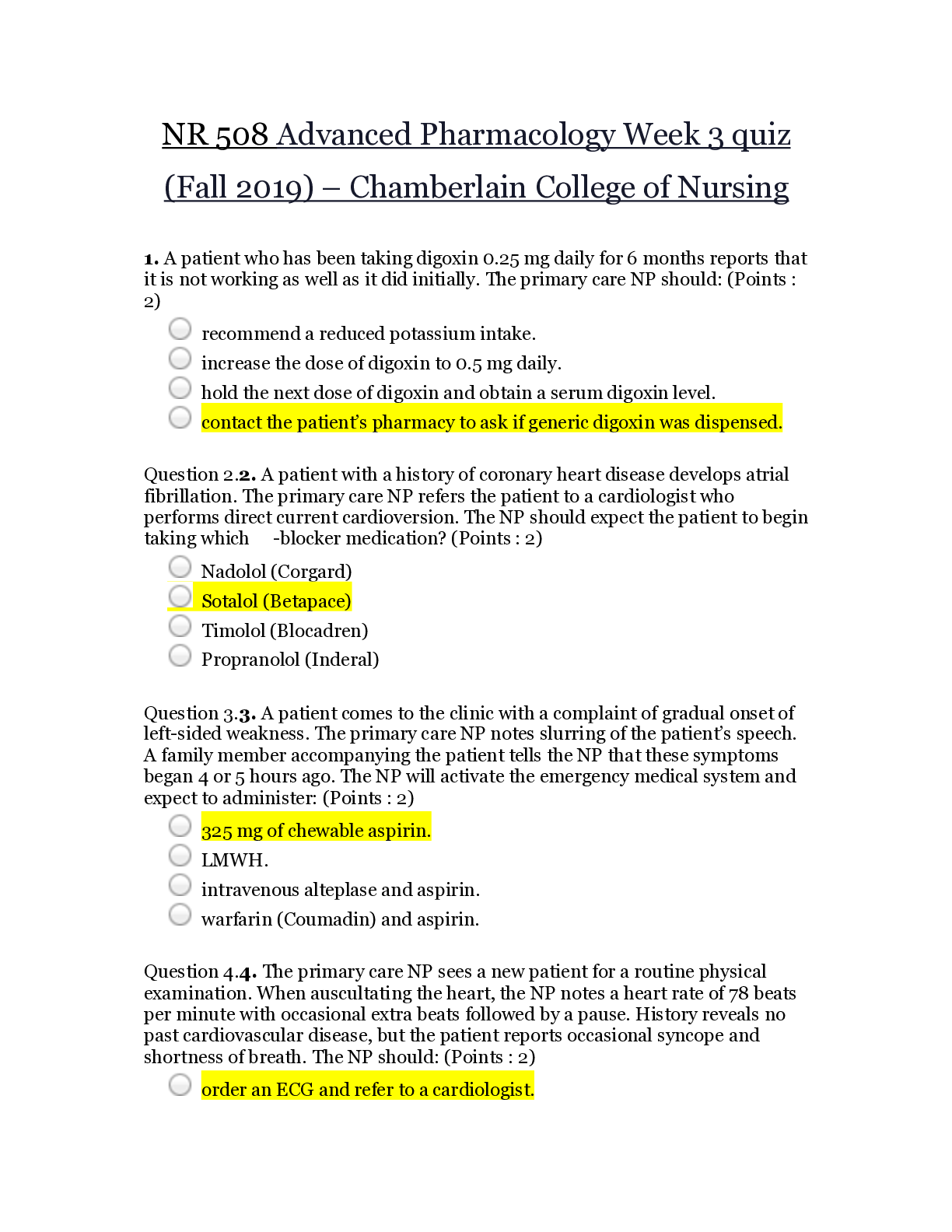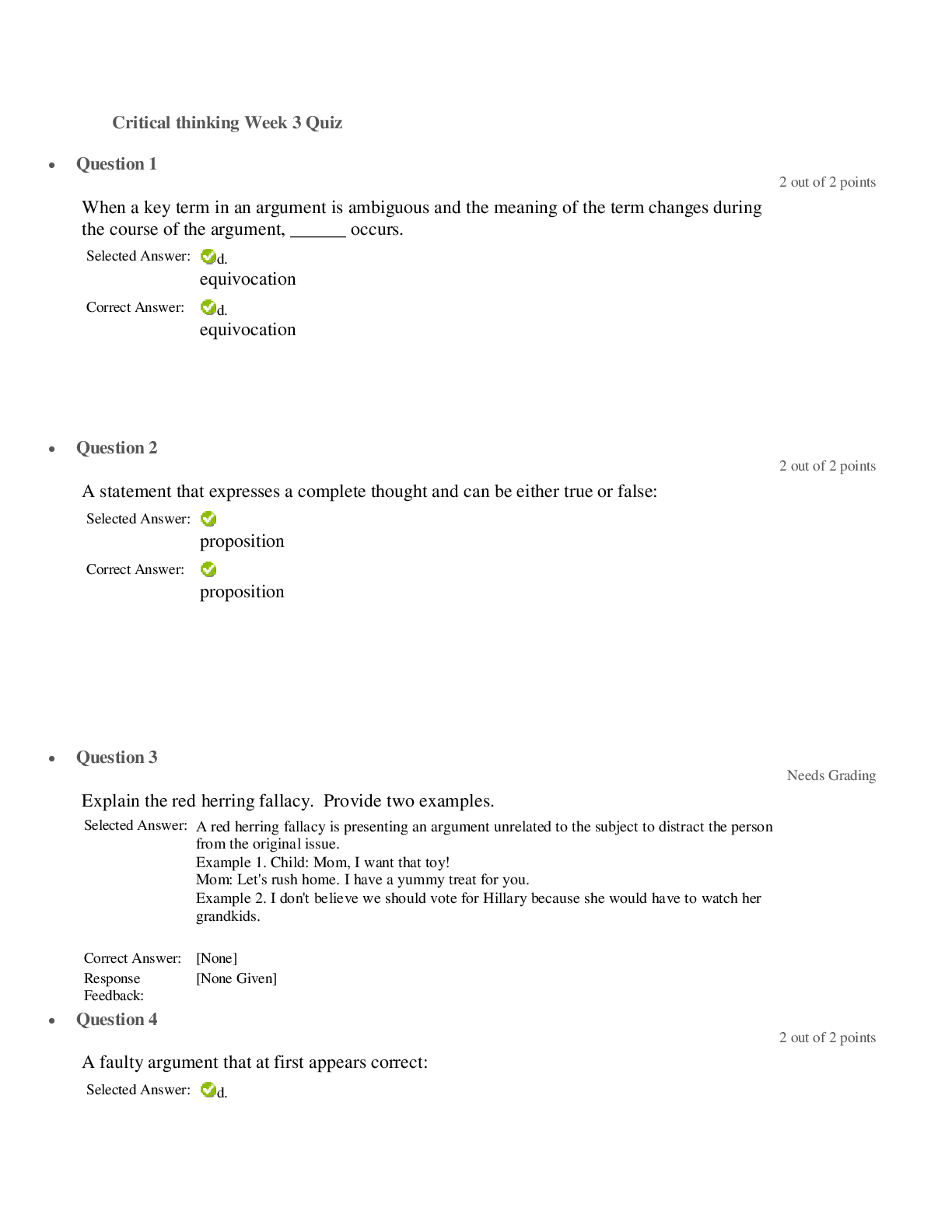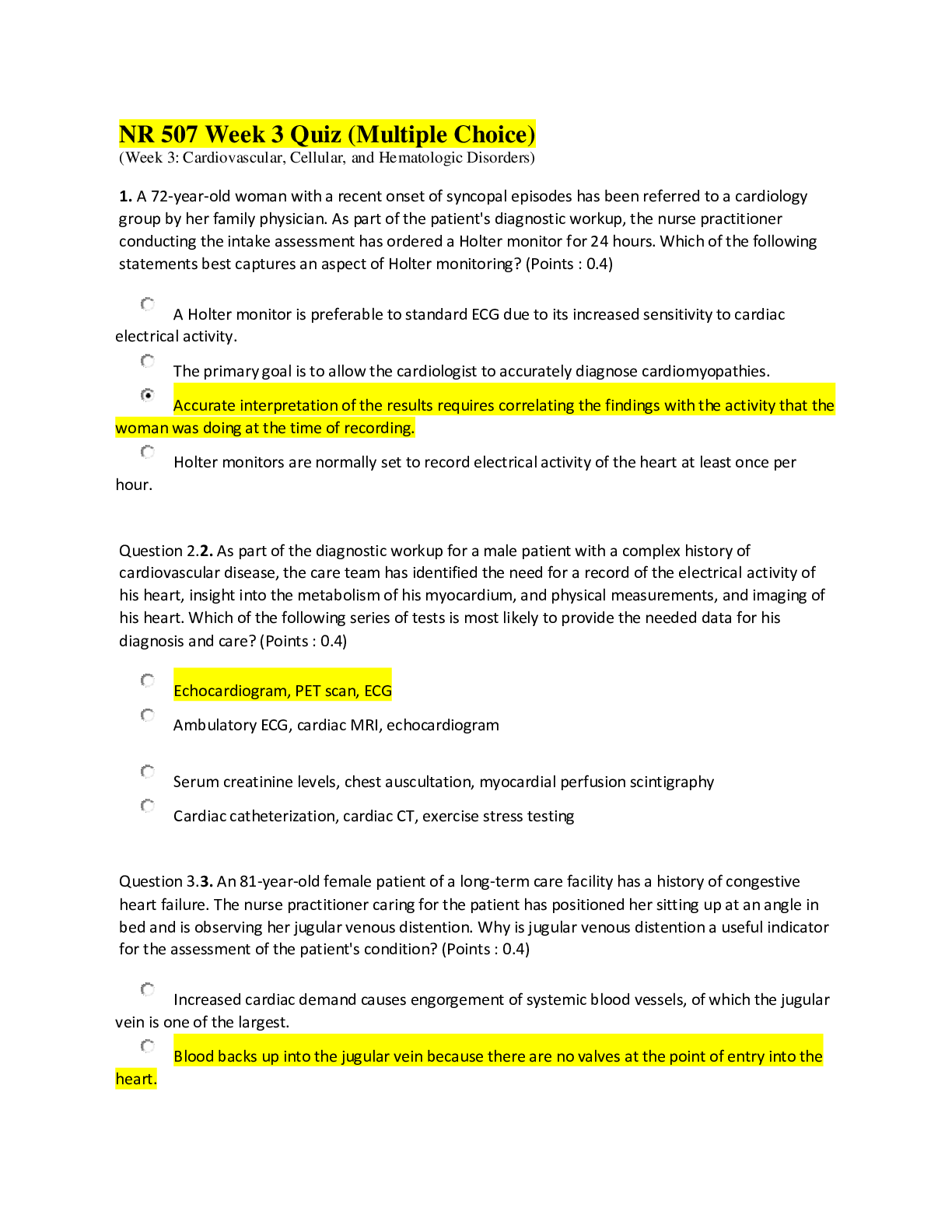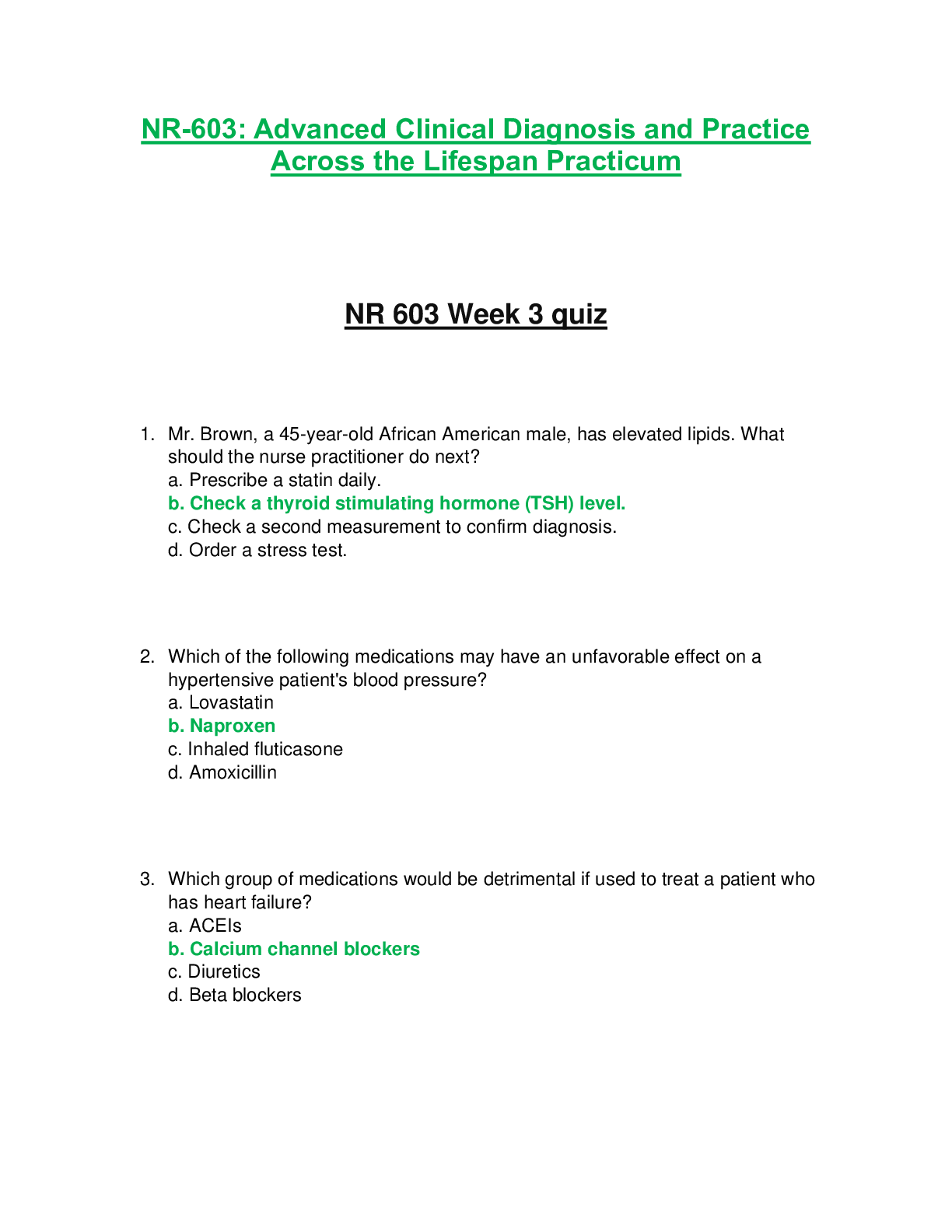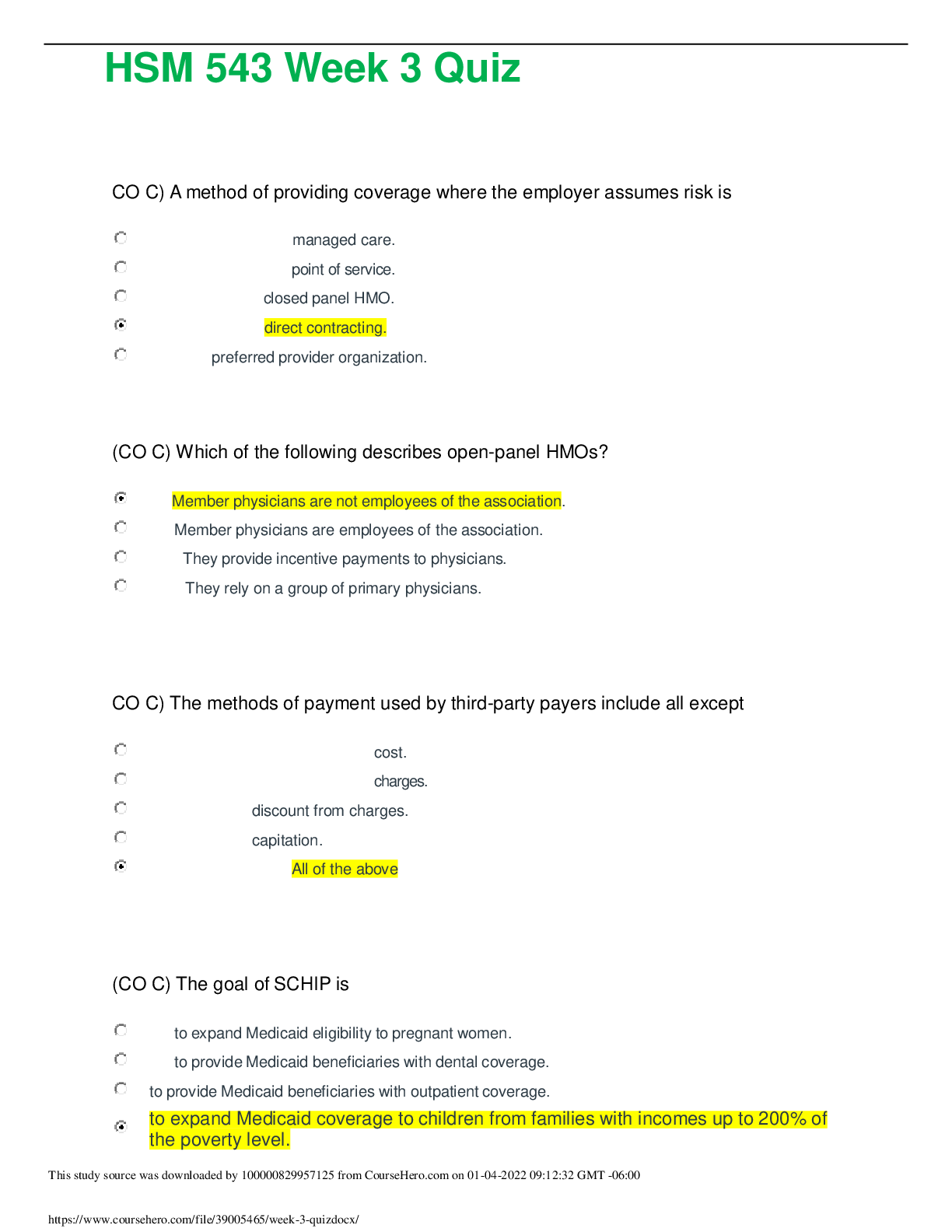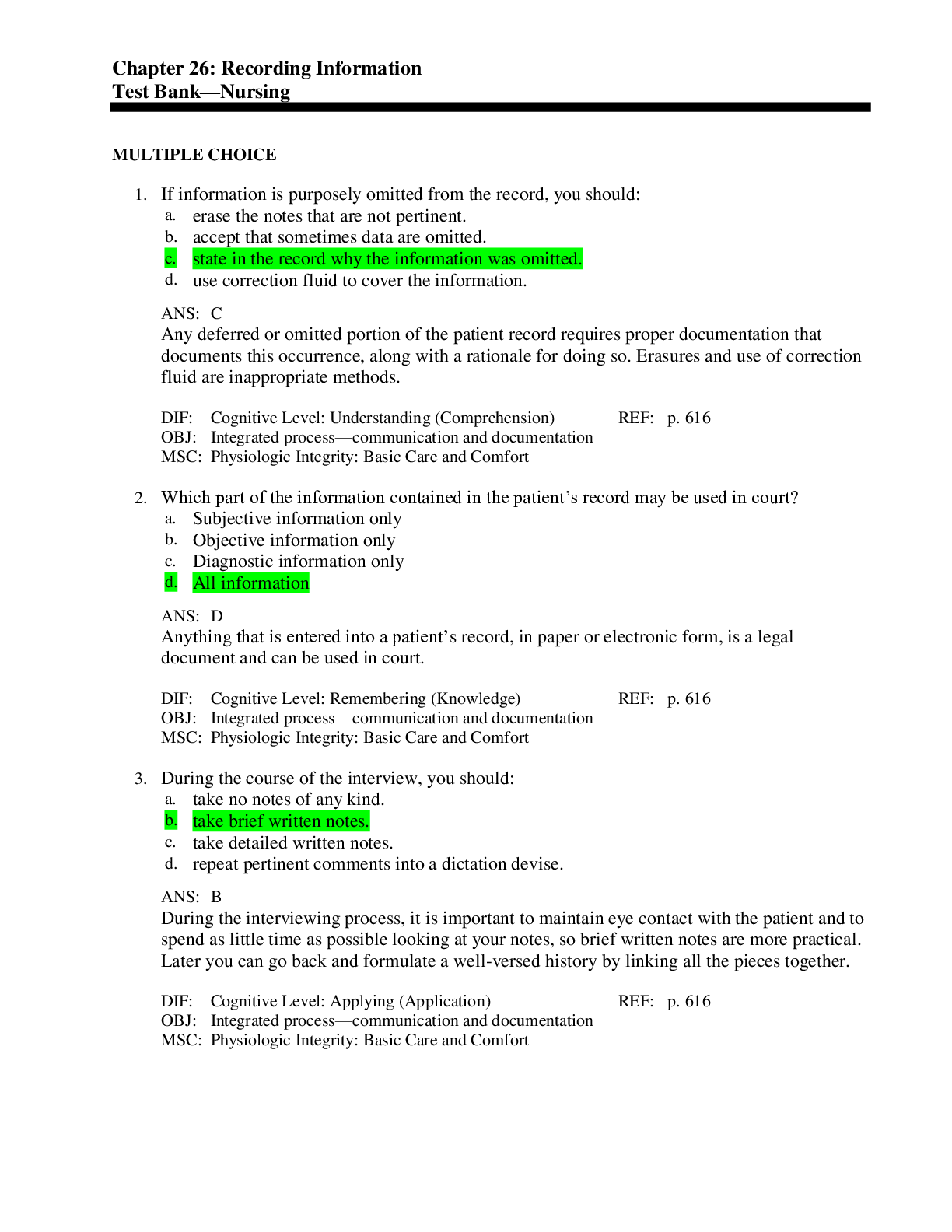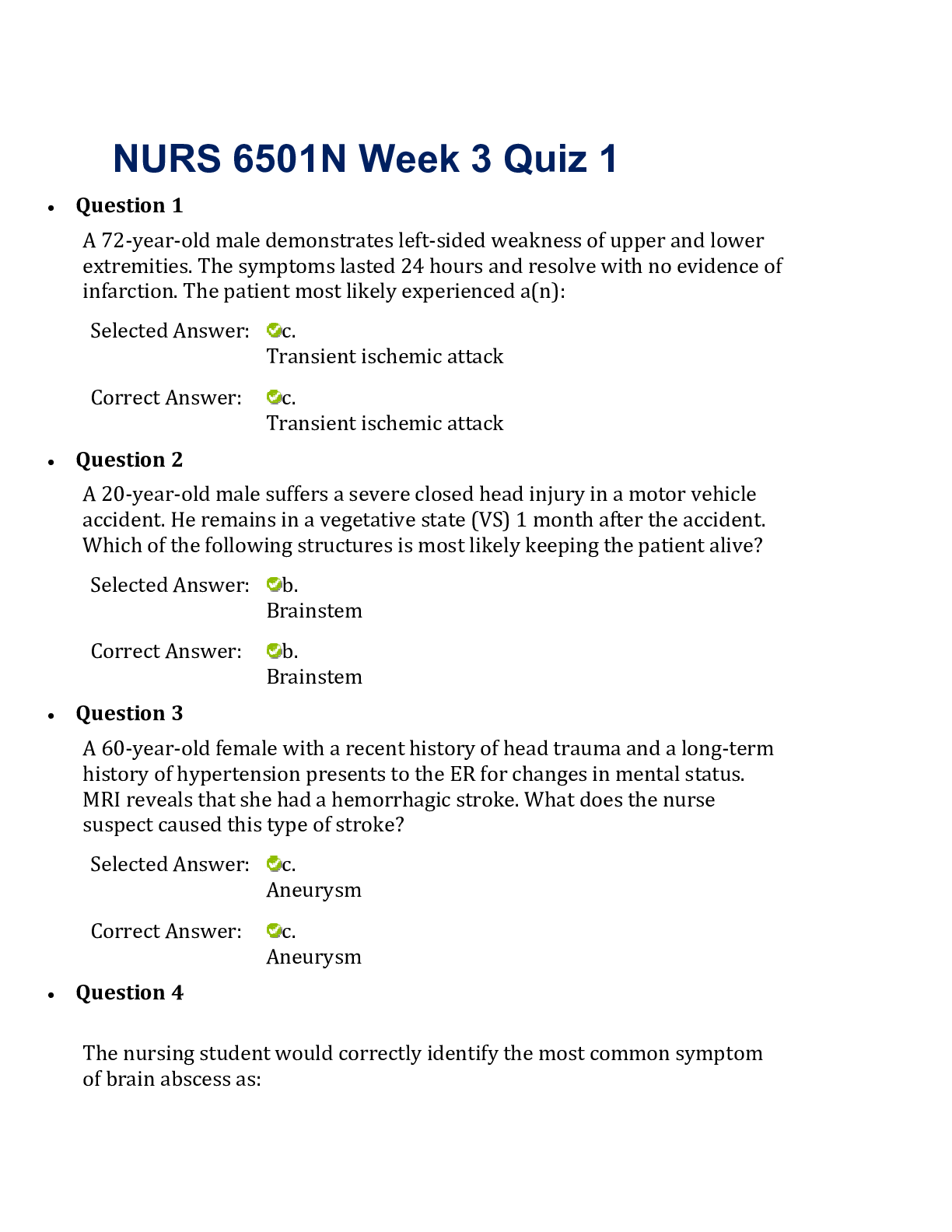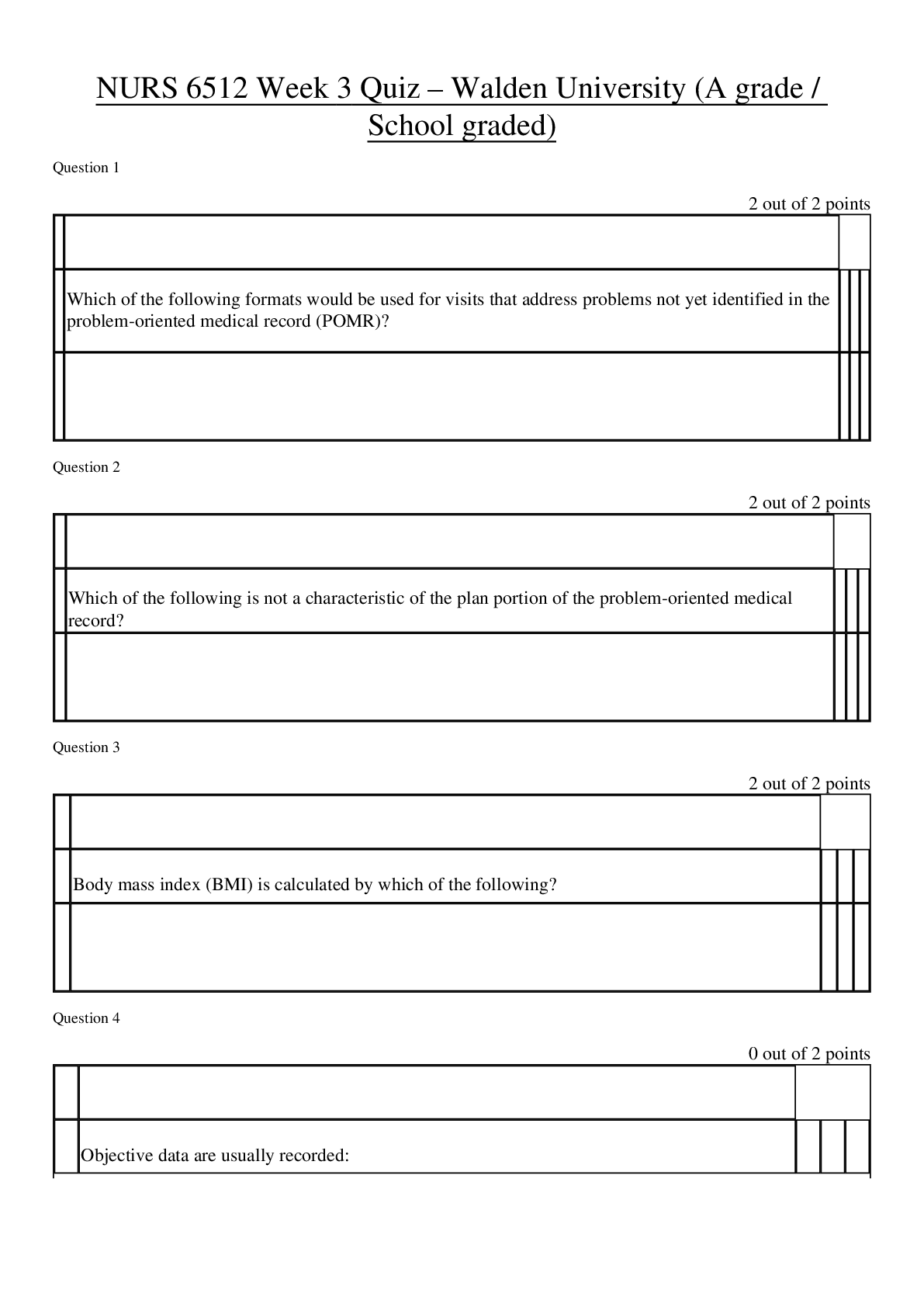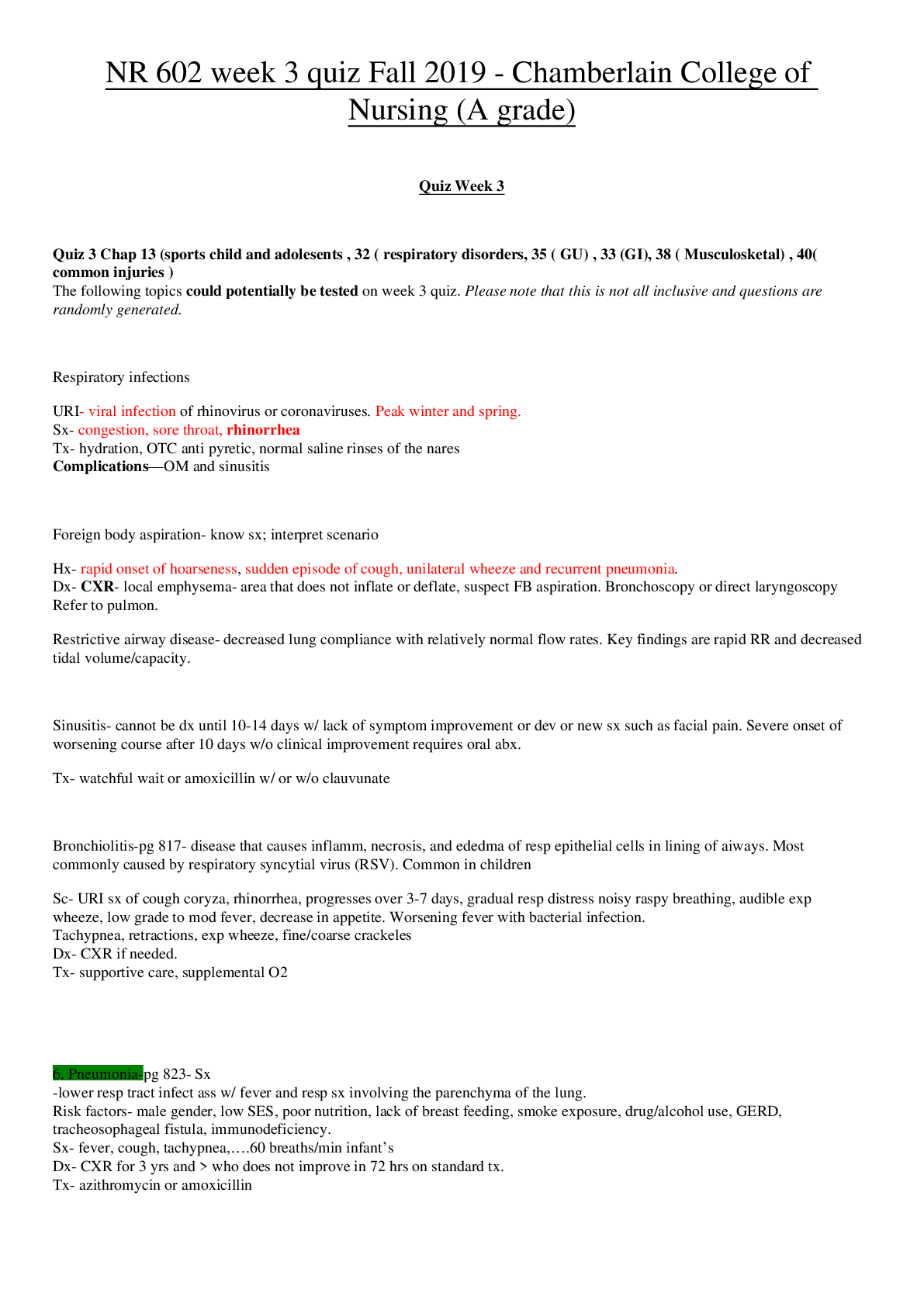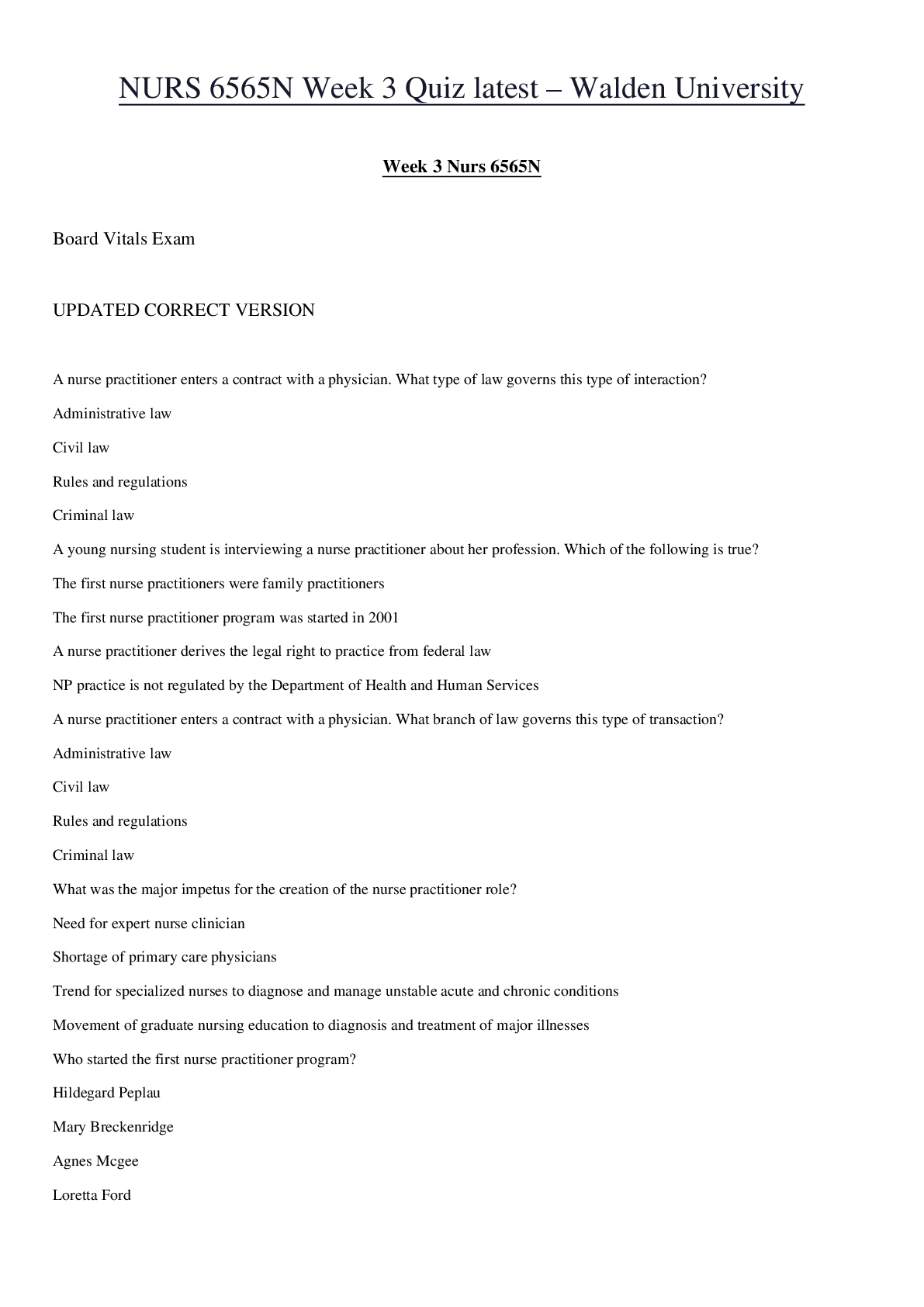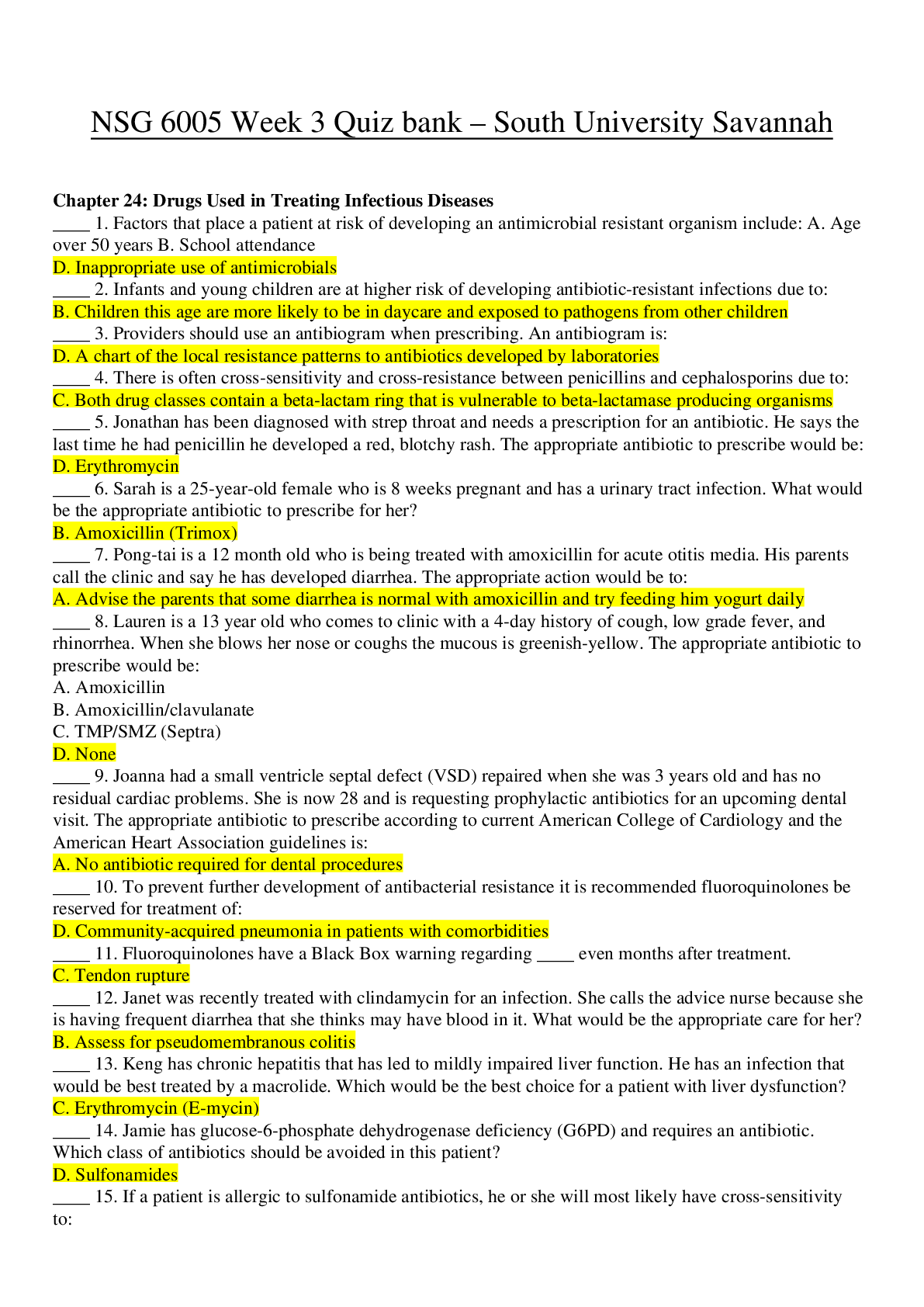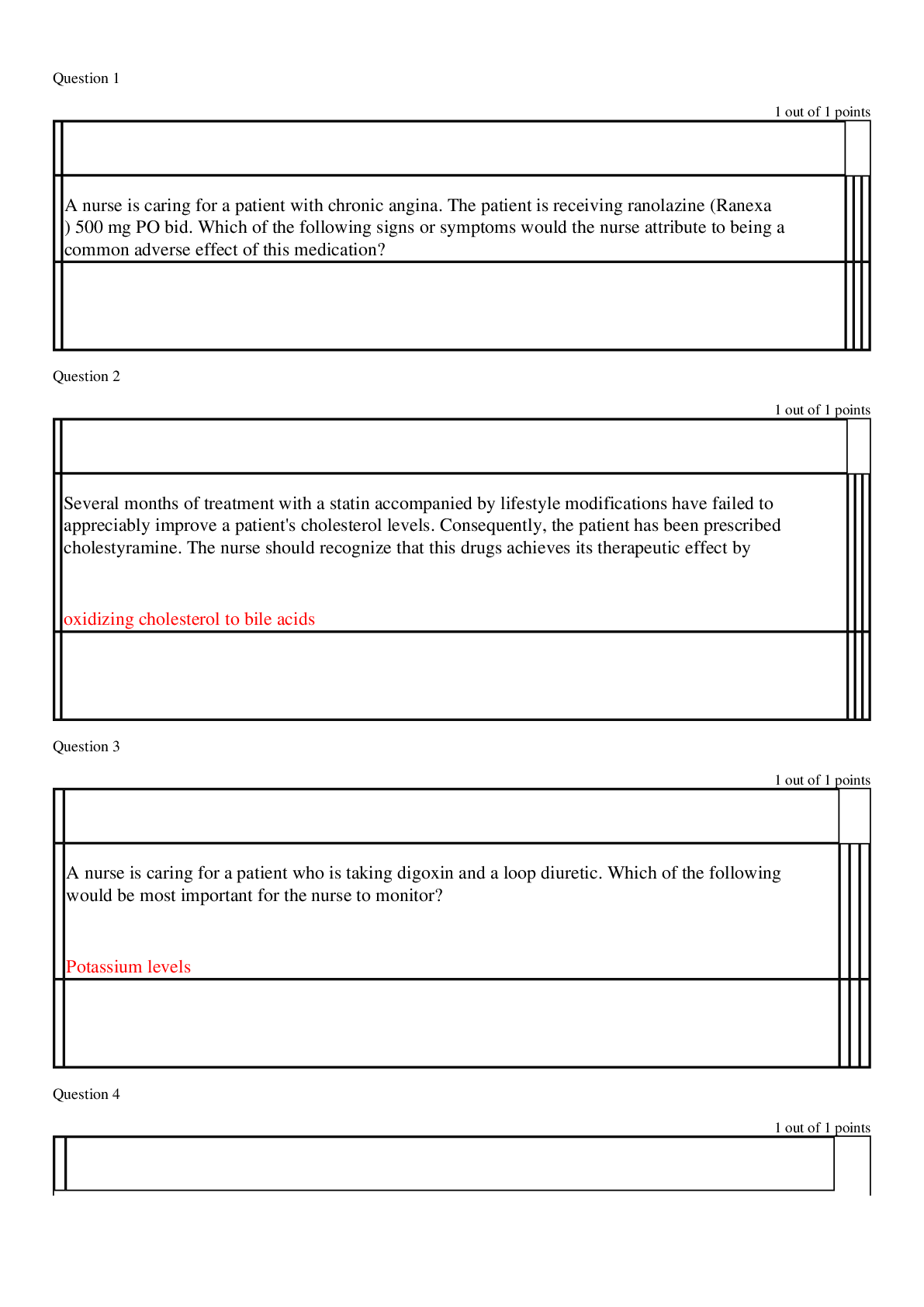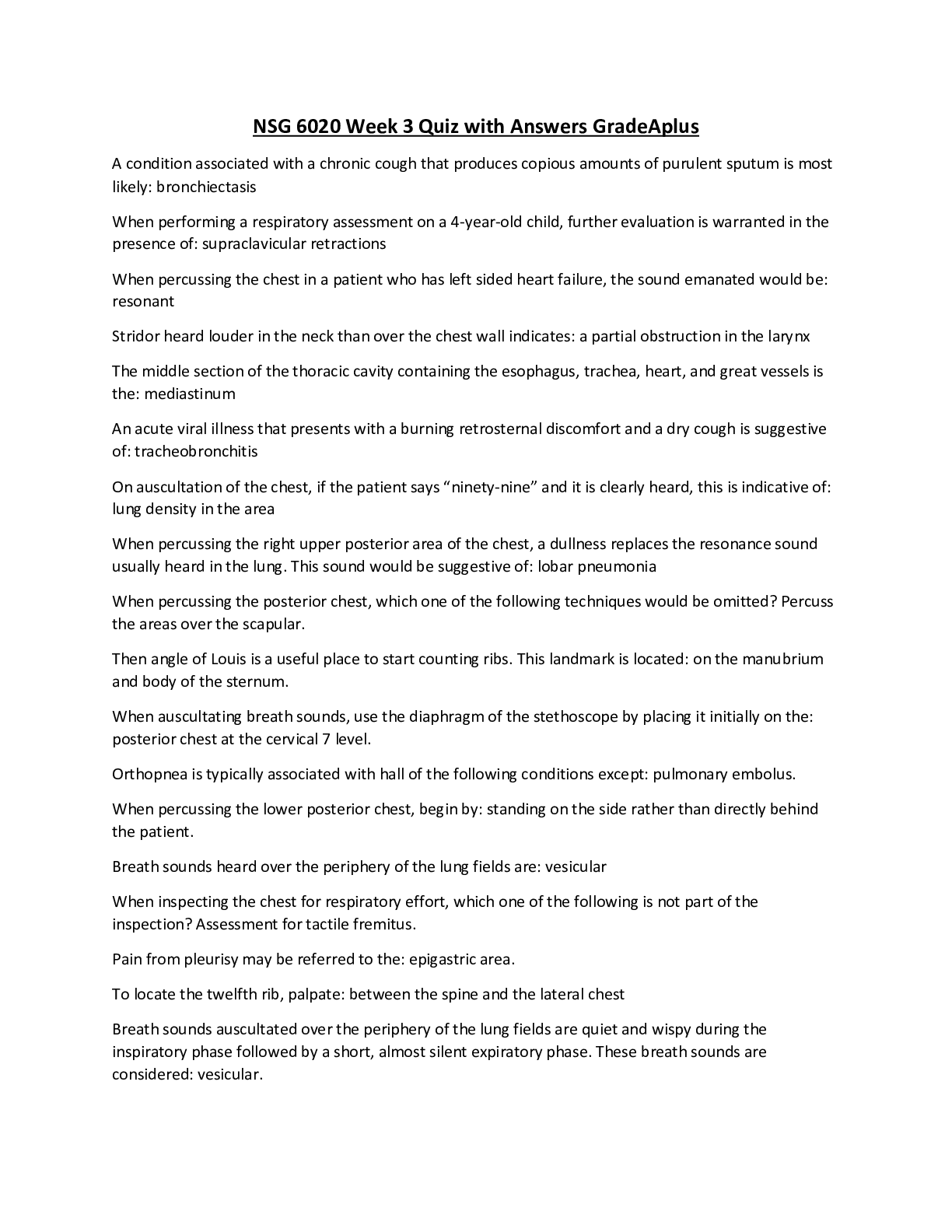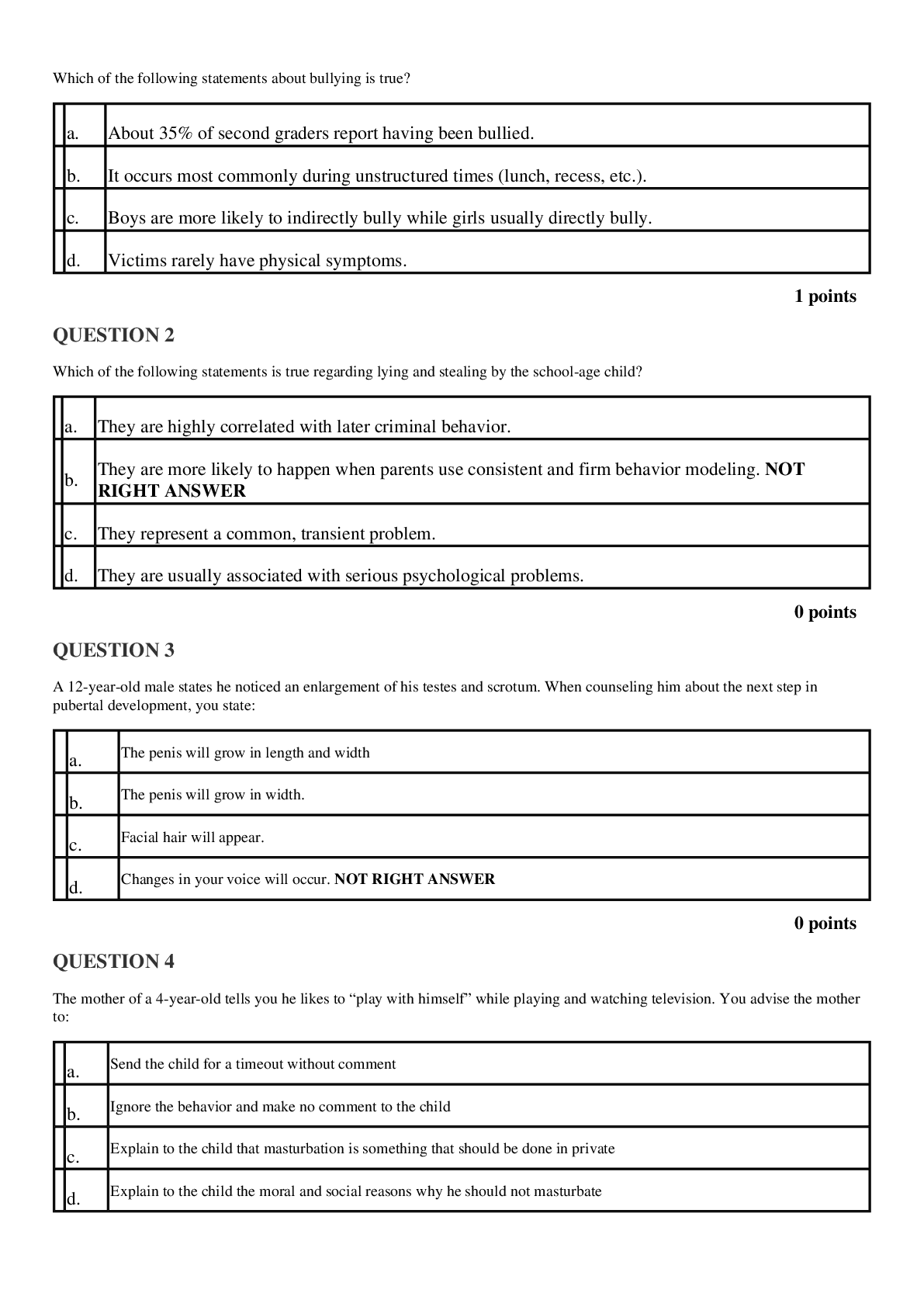*NURSING > EXAM > South University, Savannah - WEEK 3 Quiz Q Bank - 2019/20 (Already Graded A+) (All)
South University, Savannah - WEEK 3 Quiz Q Bank - 2019/20 (Already Graded A+)
Document Content and Description Below
Chapter 24: Drugs Used in Treating Infectious Diseases ____ 1. Factors that place a patient at risk of developing an antimicrobial resistant organism include: A. Age over 50 years B. School attendanc... e ____ 2. Infants and young children are at higher risk of developing antibiotic-resistant infections due to: ____ 3. Providers should use an antibiogram when prescribing. An antibiogram is: ____ 4. There is often cross-sensitivity and cross-resistance between penicillins and cephalosporins due to: ____ 5. Jonathan has been diagnosed with strep throat and needs a prescription for an antibiotic. He says the last time he had penicillin he developed a red, blotchy rash. The appropriate antibiotic to prescribe would be: ____ 6. Sarah is a 25-year-old female who is 8 weeks pregnant and has a urinary tract infection. What would be the appropriate antibiotic to prescribe for her? ____ 7. Pong-tai is a 12 month old who is being treated with amoxicillin for acute otitis media. His parents call the clinic and say he has developed diarrhea. The appropriate action would be to: ____ 8. Lauren is a 13 year old who comes to clinic with a 4-day history of cough, low grade fever, and rhinorrhea. When she blows her nose or coughs the mucous is greenish-yellow. The appropriate antibiotic to prescribe would be: A. Amoxicillin B. Amoxicillin/clavulanate C. TMP/SMZ (Septra) D. None ____ 9. Joanna had a small ventricle septal defect (VSD) repaired when she was 3 years old and has no residual cardiac problems. She is now 28 and is requesting prophylactic antibiotics for an upcoming dental visit. The appropriate antibiotic to prescribe according to current American College of Cardiology and the American Heart Association guidelines is: ____ 10. To prevent further development of antibacterial resistance it is recommended fluoroquinolones be reserved for treatment of: ____ 11. Fluoroquinolones have a Black Box warning regarding ____ even months after treatment. ____ 12. Janet was recently treated with clindamycin for an infection. She calls the advice nurse because she is having frequent diarrhea that she thinks may have blood in it. What would be the appropriate care for her? ____ 13. Keng has chronic hepatitis that has led to mildly impaired liver function. He has an infection that would be best treated by a macrolide. Which would be the best choice for a patient with liver dysfunction? ____ 14. Jamie has glucose-6-phosphate dehydrogenase deficiency (G6PD) and requires an antibiotic. Which class of antibiotics should be avoided in this patient? ____ 15. If a patient is allergic to sulfonamide antibiotics, he or she will most likely have cross-sensitivity to: A. Loop diuretics B. Sulfonylureas C. Thiazide diuretics D. All of the above ____ 16. Tetracyclines such as minocycline are safe to use in: ____ 17. Tetracyclines should not be prescribed to children younger than 8 years due to: ____ 18. Nicole is a 16 year old who is taking minocycline for acne. She comes to the clinic complaining of a headache. What would be the plan of care? ____ 19. Patricia has been prescribed doxycycline for a Chlamydia infection. She is healthy and her only medication is an oral combined contraceptive. Patricia’s education would include: ____ 20. To prevent the development of peripheral neuropathy in patients taking isoniazid for tuberculosis the patient is also prescribed: ____ 21. Sadie is an 82-year-old patient who has herpes zoster (shingles) and would benefit from an antiviral such as valacyclovir. Prior to prescribing valacyclovir she will need assessment of: ____ 22. When prescribing acyclovir, patients should be educated regarding: ____ 23. Nicholas has been diagnosed with Type A influenza. Appropriate prescribing of oseltamivir (Tamiflu) would include: ____ 24. Monitoring for patients who are on long-term antifungal therapy with ketoconazole includes: ____ 25. When prescribing metronidazole (Flagyl) to treat bacterial vaginosis, patient education would include: Chapter 26: Drugs Used in Treating Eye and Ear Disorders ____ 1. The Centers for Disease Control recommends all newborn infants receive prophylactic administration of ____ within 1 hour of birth. ____ 2. Conjunctivitis in a child that is accompanied by acute otitis media is treated with: ____ 3. Twenty-year-old Annie comes to clinic complaining of copious yellow-green eye discharge. Gram stain indicates she most likely has gonococcal conjunctivitis. While awaiting the culture results, the plan of care should be: ____ 4. Education of women who are being treated with ophthalmic antibiotics for conjunctivitis includes: ____ 5. Sadie was prescribed betaxolol ophthalmic drops by her ophthalmologist to treat her glaucoma. Oral beta blockers should be avoided in patients who use ophthalmic beta blockers due to: ____ 6. David presents to clinic with symptoms of allergic conjunctivitis. He is prescribed cromolyn sodium (Opticrom) eye drops. The education regarding using cromolyn eye drops includes: ____ 7. Ciprofloxacin otic drops are contraindicated in: ____ 8. ____ is prescribed to prevent swimmer’s ear. ____ 9. Patient education regarding the use of ciprofloxacin-hydrocortisone (Cipro HC otic) ear drops includes: ____ 10. Janie presents to clinic with hard ear wax in both ear canals. Instructions regarding home removal of hard cerumen includes: Chapter 37: Human Immunodeficiency Virus Disease and Acquired Immunodefiency Syndrome ____ 1. The goals of treatment when prescribing antiretroviral medication to patients with HIV include: A. Prevent vertical HIV transmission B. Improve quality of life C. Prolong survival ____ 2. A challenge faced with antiretroviral therapy (ART) is: ____ 3. Predictors for successful treatment with antiretroviral therapy (ART) in HIV-positive patients include: ____ 4. The goal of antiretroviral therapy (ART) in HIV-positive patients is: ____ 5. Pregnant women who are HIV positive: ____ 6. Antiretroviral therapy is recommended for HIV-positive patients with: A. A history of AIDS-defining illness B. Pregnant women C. Hepatitis B co-infection D. All of the above ____ 7. If considering starting a patient on the nucleoside reverse transcriptase inhibitor (NRTI)abacavir, the following testing is recommended prior to prescribing: ____ 8. Suzanne is pregnant and has tested HIV positive. Which antiretroviral drug should be avoided in women who are pregnant? ____ 9. The cost of HIV treatment can be prohibitive for any patient. Patients can receive assistance from the: ____ 10. Resistance to antiretroviral therapy (ART) is measured by: ____ 11. Phenotype assays are used to measure ____ of antiretroviral therapy (ART). ____ 12. Patient factors that contribute to antiretroviral therapy (ART) failure include: ____ 13. Patients who are taking antiretroviral therapy (ART) need to have the following monitored: ____ 14. Successful antiretroviral therapy (ART) in an HIV-positive patient is determined by: [Show More]
Last updated: 1 year ago
Preview 1 out of 6 pages
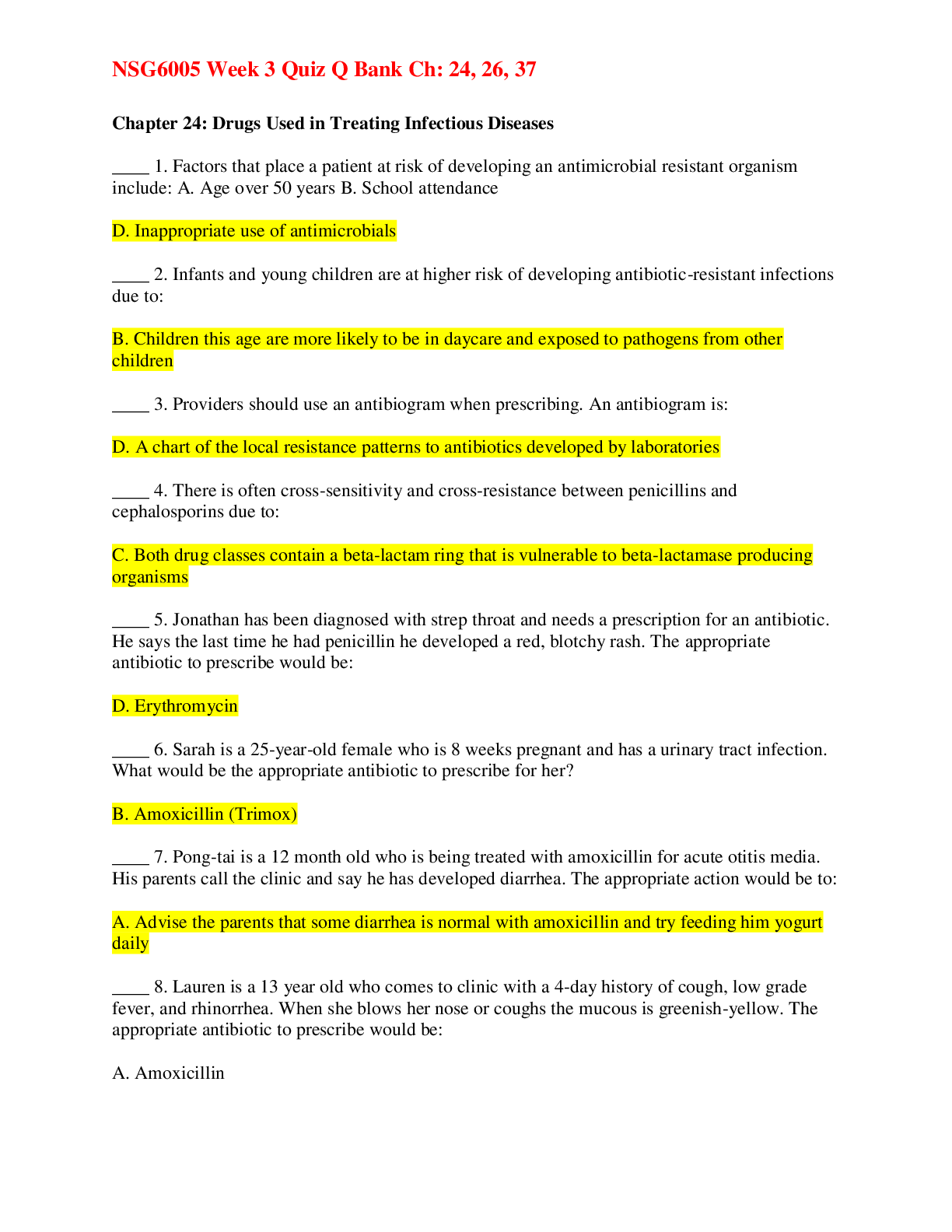
Reviews( 0 )
Document information
Connected school, study & course
About the document
Uploaded On
Oct 21, 2019
Number of pages
6
Written in
Additional information
This document has been written for:
Uploaded
Oct 21, 2019
Downloads
0
Views
73



